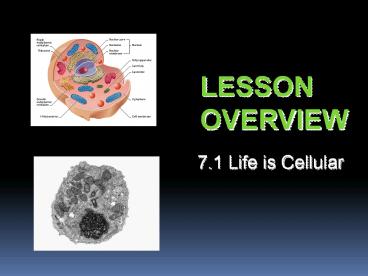LESSON OVERVIEW - PowerPoint PPT Presentation
Title:
LESSON OVERVIEW
Description:
LESSON OVERVIEW 7.1 Life is Cellular THINK ABOUT IT What s the smallest part of any living thing that still counts as being alive? Can we just keep dividing ... – PowerPoint PPT presentation
Number of Views:144
Avg rating:3.0/5.0
Title: LESSON OVERVIEW
1
LESSON OVERVIEW
- 7.1 Life is Cellular
2
THINK ABOUT IT
- Whats the smallest part of any living thing
that still counts as being alive? - Can we just keep dividing living things into
smaller and smaller parts, or is there a point at
which whats left is no longer alive? - As you will see, there is such a limit. The
smallest living unit of any organism is the cell.
3
Early Microscopes
- In 1665, Englishman Robert Hooke used an early
compound microscope to look at a nonliving thin
slice of cork, a plant material. - Under the microscope, cork seemed to be made of
thousands of tiny, empty chambers that Hooke
called cells. The term cell is used in biology
to this day.
4
- In Holland, Anton van Leeuwenhoek examined pond
water and other things, including a sample taken
from a human mouth. He drew the organisms he saw
in the mouthwhich today we call bacteria.
5
The Cell Theory
- Soon after Leeuwenhoek, observations made by
other scientists made it clear that cells were
the basic units of life. - In 1838, German botanist Matthias Schleiden
concluded that all plants are made of cells.
6
- The next year, German biologist Theodor Schwann
stated that all animals were made of cells.
7
- These discoveries are summarized in the cell
theory, a fundamental concept of biology. - The cell theory states
- -All living things are made up of cells.
- -Cells are the basic units of structure and
function in living things. - -New cells are produced from existing cells.
8
Exploring the Cell
- How do microscopes work?
- Most microscopes use lenses to magnify the
image of an object by focusing light or electrons.
9
Light Microscopes
- A typical light microscope allows light to pass
through a specimen and uses two lenses to form an
image. - The first set of lenses, located just above the
specimen, produces an enlarged image of the
specimen. - The second set of lenses magnifies this image
still further. - Because light waves are diffracted, or
scattered, as they pass through matter, light
microscopes can produce clear images of objects
only to a magnification of about 1000 times.
10
Electron Microscopes
- Light microscopes can be used to see cells and
cell structures as small as 1 millionth of a
meter. To study something smaller than that,
scientists need to use electron microscopes. - Electron microscopes use beams of electrons, not
light, that are focused by magnetic fields. - Electron microscopes offer much higher
resolution than light microscopes. - Electron microscopy can be used to examine only
nonliving cells and tissues.
11
Prokaryotes and Eukaryotes
- How are prokaryotic and eukaryotic cells
different? - Prokaryotic cells do not separate their genetic
material within a nucleus. - In eukaryotic cells, the nucleus separates the
genetic material from the rest of the cell.
12
- Cells fall into two broad categories, depending
on whether they contain a nucleus. - The nucleus is a large membrane-enclosed
structure that contains the cells genetic
material in the form of DNA. The nucleus controls
many of the cells activities.
13
Prokaryotes and Eukaryotes
- Eukaryotes are cells that enclose their DNA in
nuclei. - Prokaryotes are cells that do not enclose DNA in
nuclei.
14
Prokaryotes
- Prokaryotic cells are generally smaller and
simpler than eukaryotic cells. - Despite their simplicity, prokaryotes grow,
reproduce, and respond to the environment, and
some can even move by gliding along surfaces or
swimming through liquids. - The organisms we call bacteria are prokaryotes.
15
Eukaryotes
- Eukaryotic cells are generally larger and more
complex than prokaryotic cells. - Most eukaryotic cells contain dozens of
structures and internal membranes. Many
eukaryotes are highly specialized. - There are many types of eukaryotes plants,
animals, fungi, and organisms commonly called
protists.































